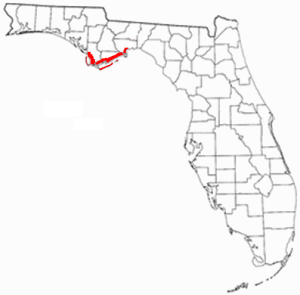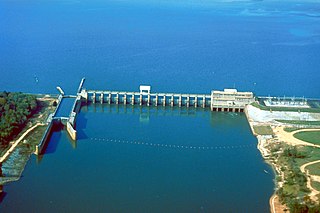
Franklin County is a county along the Gulf of Mexico in the panhandle of the U.S. state of Florida. As of the 2020 census, the population was 12,451, making it the third-least populous county in Florida. The county seat is Apalachicola.

Apalachicola is a city and the county seat of Franklin County, Florida, United States, on the shore of Apalachicola Bay, an inlet of the Gulf of Mexico. The population was 2,231 at the 2010 census.

The Apalachicola River is a river, approximately 160 miles (260 km) long, in the state of Florida. The river's large watershed, known as the Apalachicola, Chattahoochee and Flint (ACF) River Basin, drains an area of approximately 19,500 square miles (50,500 km2) into the Gulf of Mexico. The distance to its farthest head waters in northeast Georgia is approximately 500 miles (800 km). Its name comes from Apalachicola Province, an association of Native American towns located on what is now the Chattahoochee River. The Spanish included what is now called the Chattahoochee River as part of one river, calling all of it from its origins in the southern Appalachian foothills down to the Gulf of Mexico the Apalachicola.

John B. Gorrie was a Nevisian-born American physician and scientist, credited as the inventor of mechanical refrigeration.

U.S. Route 319 is a spur of US 19. It runs for 303 miles (488 km) from US 98 at the foot of the John Gorrie Memorial Bridge across from downtown Apalachicola, Florida to US 1/SR 4 in Wadley, Georgia, through the Panhandle of Florida and the southern portion of Georgia.

The Florida Panhandle is the northwestern part of the U.S. state of Florida. It is a salient roughly 200 miles long, bordered by Alabama on the north and the west, Georgia on the north, and the Gulf of Mexico to the south. Its eastern boundary is arbitrarily defined. It is defined by its southern culture and rural geography relative to the rest of Florida, as well as closer cultural links to French-influenced Louisiana, Mississippi, and Alabama. Its major communities include Pensacola, Navarre, Destin, Panama City Beach, and Tallahassee.

Prospect Bluff Historic Sites is located in Franklin County, Florida, on the Apalachicola River, 6 miles (9.7 km) SW of Sumatra, Florida. The site contains the ruins of two forts.

Torreya State Park is a 13,735 acre (56 km²) Florida State Park, United States National Natural Landmark and historic site thirteen miles (19 km) north of Bristol. It is located north of S.R 12 on the Apalachicola River, in northwestern Florida, at 2576 N.W. Torreya Park Road.

The Trammell Bridge is 1.6 miles (2.6 km) long and carries State Road 20 over the Apalachicola River in the Florida Panhandle between Blountstown and Bristol. It is named for three members of the Trammell family: (1) U.S. Senator from Florida and former governor Park M. Trammell, who died in office in 1936; (2) his brother, John D. Trammell, member of the Florida legislature representing Calhoun County (Blountstown) who introduced the bill to construct the original bridge; and (3) Robert D. Trammell, John Trammell's grandson who represented the area in the Florida legislature and secured funding for the new bridge.

The Forgotten Coast refers to a largely untouched and uninhabited area of coastline in the panhandle of the US state of Florida. The term, also a trademark, was first used in 1992, but the Forgotten Coast's exact location is not agreed upon.

The Orman House is a Florida State Park and historic site located in Apalachicola, in northwestern Florida. The address is 177 5th Street.

Alvan Wentworth Chapman was an American physician and pioneering botanist in the study of flora of the American Southeast. He wrote Flora of the Southern United States, the first comprehensive description of US plants in any region beyond the northeastern states.

Lake Seminole is a reservoir located in the southwest corner of Georgia along its border with Florida, maintained by the U.S. Army Corps of Engineers. The Chattahoochee and Flint rivers join in the lake, before flowing from the Jim Woodruff Lock and Dam, which impounds the lake, as the Apalachicola River. The lake contains 37,500 acres (152 km2) of water, and has a shoreline of 376 mi (605 km). The fish in Lake Seminole include largemouth bass, crappie, chain pickerel, catfish, striped bass and other species. American alligators, snakes and various waterfowl are also present in the lake, which is known for its goose hunting.

Trinity Episcopal Church, originally known as Christ Church, is a historic house of worship in Apalachicola, Florida, United States, located at the corner of Avenue D and 6th Street. On June 30, 1972, it was added to the U.S. National Register of Historic Places.

The Big Bend of Florida, United States, is an informally-named geographic region of North Florida where the Florida Panhandle transitions to the Florida Peninsula south and east of Tallahassee. The region is known for its vast woodlands and marshlands and its low population density relative to much of the state. The area is home to the largest single spring in the United States, the Alapaha Rise, and the longest surveyed underwater cave in the United States, the 32-mile (51 km) Wakulla-Leon Sinks cave system.


Brasfield & Gorrie, LLC, headquartered in Birmingham, Alabama, is one of the United States' largest privately held construction firms, providing general contracting, design-build, and construction management services for a wide variety of markets. Founded in 1964, Brasfield & Gorrie has 12 offices and approximately 2,600 employees. Its 2019 revenues were $3.80 billion. Engineering News-Record ranks Brasfield & Gorrie 30th among the nation’s “Top 400 Contractors” for 2017. Modern Healthcare ranks the company third among healthcare general contractors in the nation.

North Florida is a region of the U.S. state of Florida comprising the northernmost part of the state. Along with South Florida and Central Florida, it is one of Florida's three most common "directional" regions. It includes Jacksonville and nearby localities in Northeast Florida, an interior region known as North Central Florida, and the Florida Panhandle.

John Gorrie is a marble sculpture depicting the American inventor and scientist of the same name by C. Adrian Pillars, installed at the United States Capitol's National Statuary Hall, in Washington, D.C., as part of the National Statuary Hall Collection. The statue was gifted by the U.S. state of Florida in 1914.




















